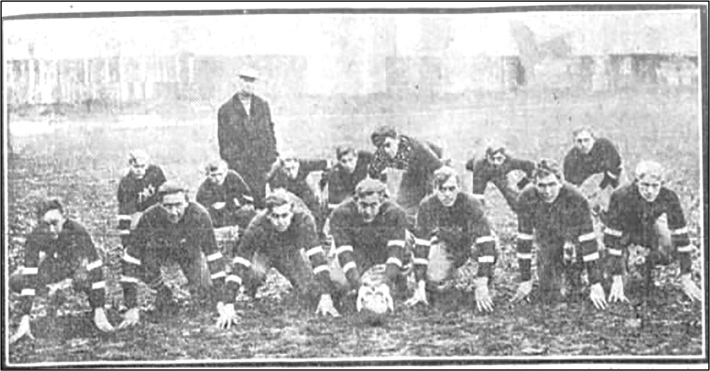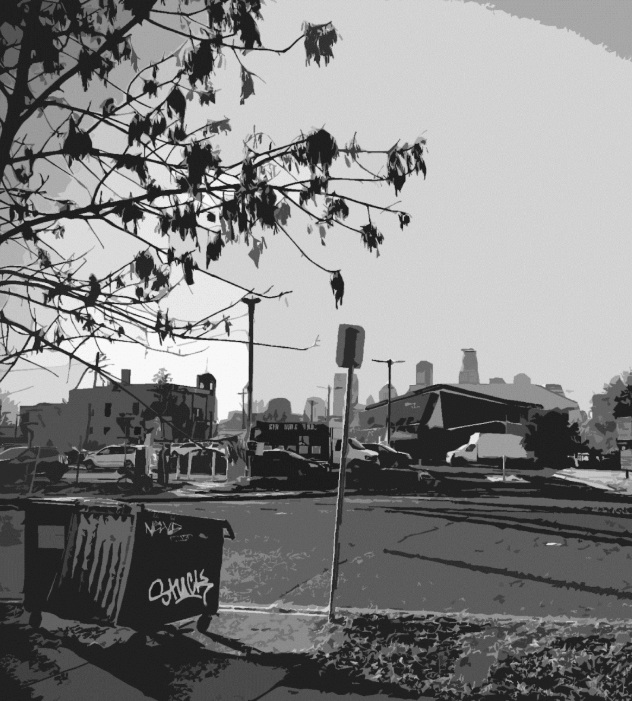On the West Bank in the Cedar-Riverside neighborhood of Minneapolis, where many East African immigrants now call home, nobody would ever accuse the disregarded patch of grass, bushes, and trees near The Red Sea Ethiopian Restaurant as someplace significant. Near Metro Transit stop No. 41705, the most interesting feature of this small piece of land at 300 Cedar Ave. is the graffiti on the side of the nearby restaurant.
If you believe in clairaudience, however, and that you can hear voices from the past, you might be able to stand there and hear a group of men discussing whether their football team should continue to play in the National Football League. No, we’re not talking about hearing the voices of Minnesota Vikings players and coaches who have passed on. We’re talking about earlier immigrants, mostly Scandinavian, who started the football team that became Minnesota’s first NFL team: The Minneapolis Marines.
Immigrants and football are joined at the hip. The poet James Wright recognized this, and arguably the most famous poem about football is his poem “Autumn Begins in Martins Ferry, Ohio.” Wright grew up in Martins Ferry, a small town in the Ohio River Basin, which is considered the cradle of professional football. Like Martins Ferry, the city of Minneapolis, Minnesota, grew up on the banks of a river, where factories filled with European immigrants helped to drive the Industrial Revolution.
In the case of Minneapolis, the immigrants included many Swedes and Norwegians who had children. And like in Martins Ferry, “some of those boys, well, they became good football players,” remarked Wright in 1968. “Why is that?” he asked rhetorically. He answered, “One reason, I suppose, was to be able to get out of that hole, and many of them did.” Wright himself lived in the Twin Cities, where from 1957 to 1963 he taught in the English Department at the University of Minnesota in Minneapolis, and later at Macalester College in St. Paul.
Scandinavian immigrants settled in south Minneapolis along Cedar and Riverside Avenues. Cedar Avenue grew to become the main Norwegian street in the city due to the establishment of Scandia Bank on the corner of Cedar & Fourth Street. The bank helped to finance Norwegian immigrant business ventures, and by the end of the 1880s nearly every business in the neighborhood was owned by Norwegians.
Throughout the neighborhood stood a haphazard assemblage of residential and commercial buildings, and the immigrants there packed themselves into the poorly constructed housing. In the mornings and evenings, residents walked en masse to work in the nearby lumber and flour mills, while others opened their shops in the neighborhood. This Scandinavian immigrant enclave is where big-time professional football was born in Minnesota. The fact our current NFL team is nicknamed the Vikings is quite apt.

Like so many early NFL teams, the Minneapolis Marines’ trajectory toward professionalism started in the sandlots, where young men played the sport for bragging rights, for the love of the game, and sometimes for a cash prize paid by the losers. Most teams played on Sundays when many blue-collar workers could attend and play.
In fact, in the early 1900s, amateur independent football began to flourish in the Twin Cities. Young working men throughout Minneapolis and St. Paul, many of them first-generation Americans, grew to love football as a form of recreation. They began to form teams, including company teams, athletic club teams, and juvenile teams, and they played in ad hoc weight classes. Newspapers in the Twin Cities encouraged teams to post notices, challenges, results, and grievances on sports pages.
The emergence of football was a good thing, because young men in Minneapolis needed a distraction. In 1905, the new mayor of Minneapolis, David P. Jones, closed whorehouses on residential streets and forced them to move to the red-light district. He also shut down gambling houses and increased enforcement of the midnight closing time for saloons. He ordered all taverns closed on Sundays.
On the south side, the mayor reorganized the police force and tamped down on public drunkenness, and at Minnehaha Park, where the “tough element of the city” gathered at night for “objectionable dances,” the mayor sent in a new park police detail to shut down parties. He asked the commandant at Fort Snelling to better control the behavior of his soldiers. As a result, young men would have to find better things to do. They found football.
In the autumn of 1905, while the amateur baseball season wound down, and while the University of Minnesota football team, fresh off its point-a-minute season, embarked on a 10-win, one-loss march through opponents, the Marines nickname first appeared in “Independent Football” columns on the sports pages of Minneapolis newspapers. The team included mostly Swedes, and the next year, they added a Norwegian named Art “Dutch” Gaustad. The left guard, and the team’s coach in 1906, Gaustad would play for the Marines for 17 seasons, including in the NFL.
The young Marines were predominantly, but not exclusively, Scandinavian. In 1907, they added other sons of immigrants from the neighborhood, including John Dunn, the son of a pioneering Minneapolis businessman, Thomas Dunn, an Irish-born woolen mill operator. For the next 12 seasons, John Dunn would play mostly halfback for the Marines, but he would also take over management of the team in 1915. Eventually, he and his financial partners would form the Marine Football and Athletic Club Incorporated to run an NFL franchise, and he would serve seven seasons as vice president of the NFL.
The other significant non-Scandinavian from the neighborhood who joined the team was Reuben “Rube” Ursella. Perhaps the most overlooked athlete in Minnesota sports history, Ursella would play for the Marines for 15 seasons, including after the Marines renamed themselves the Minneapolis Red Jackets in 1929. Like many other Marines players, he eventually went on to play for other NFL teams. He may be the only player to have played in the final game for three separate NFL franchises, for the Rock Island Independents in 1925 and for the Hammond Pros and Akron Indians in 1926. Hall-of-fame sportswriter Halsey Hall once wrote a feature in the Minneapolis Journal about Ursella, and he called him “one of the greatest football players the west has been proud of, collegiate, scholastic, or otherwise.” Ursella was known for his kicking ability, and he once made a 54-yard drop-kick field goal in 1913.
In the early days, the Marines were just a sandlot team, but they formed the Marine Athletic Club and established their clubhouse in the upper chambers of a building at 300 Cedar Ave., where the Minneapolis Brewing Co. once had a saloon on the main floor. By 1913, the Marines established themselves as an independent professional team, and in 1915 they made Nicollet Park, the home of the Minneapolis Millers professional baseball team, their home venue for games at Nicollet Avenue & 31st Street. The Marines joined the NFL in 1921 and played in the league for six seasons, first as the Marines (1921-1924) and then as the Red Jackets (1929-1930) until financial woes forced the team to quit. Thirty-one years later, the Minnesota Vikings would arrive as an expansion team.
You can no longer stand in the upper chambers of the building where NFL football in Minnesota originated. But you can stand in an empty lot at 300 Cedar Ave., and while standing there at the foot of the place where a few Scandinavians once decided they should start a football team, you can have an unimpeded view of the east gate at U.S. Bank Stadium and the administrative offices of the Vikings.

Ryan “R. C.” Christiansen is a pro football historian, a member of the Professional Football Researchers Association, and the author of Mill City Scrum: The History of Minnesota’s First Team in the National Football League and of Border Boys: How Americans from Border Colleges Helped Western Canada to Win a Football Championship.







